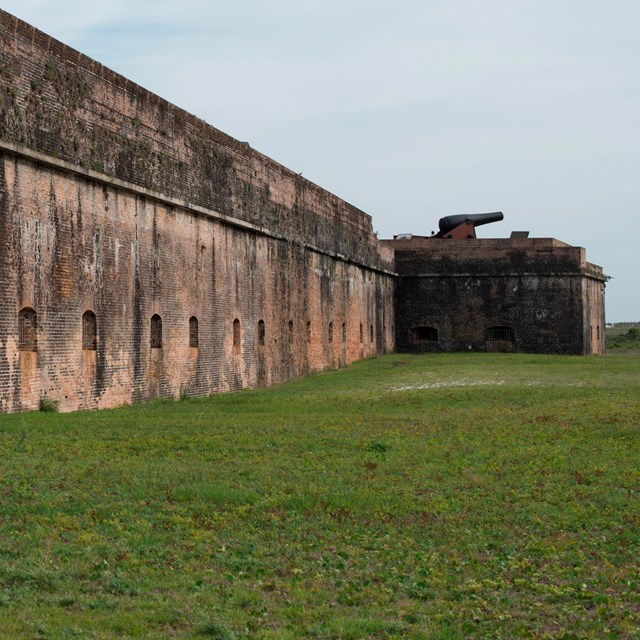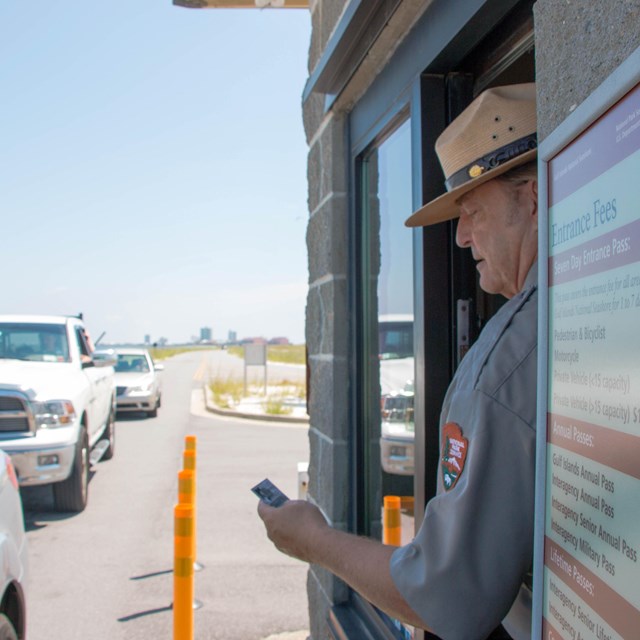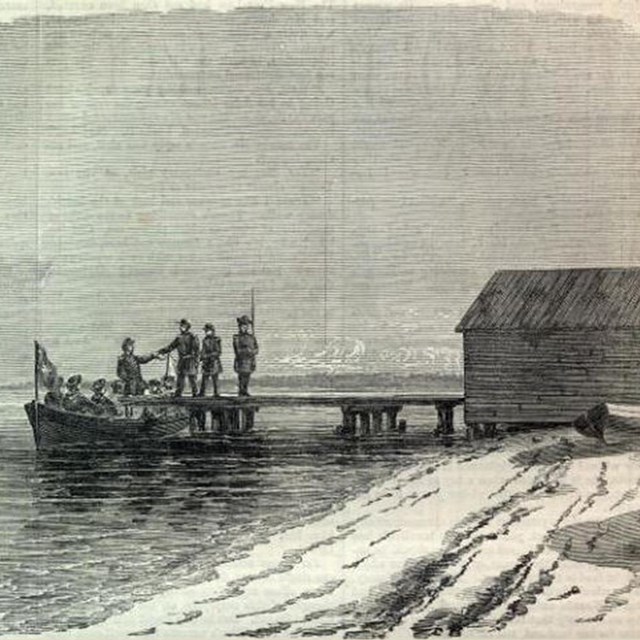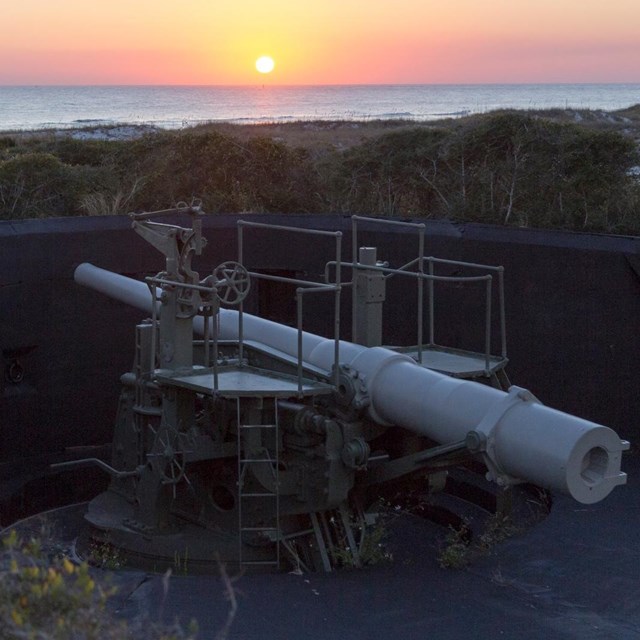
NPS Photo In 1816, the United States began constructing Third System forts along its coastline to protect important waterways and seaports. Five years later, the federal government began fortifying areas along Florida’s 3,500 mile seaboard. Pensacola Bay was one such area. European powers had long considered Pensacola Bay one of the most important on the northern Gulf Coast. With depths ranging between 20–65 feet and a length of about 13 miles, the bay afforded excellent anchorage and protection for ships. After the Adams-Onís Treaty of 1819, also called the Transcontinental Treaty, in which Spain ceded East and West Florida to the US, Pensacola Bay became US territory. In 1825, President James Monroe signed a law establishing a new navy yard and depot on the bay. Forts were needed to protect the natural bay and navy yard, and thus Fort Pickens was conceived. Fort Pickens was designed and constructed to defend Pensacola Bay and the Pensacola Navy Yard and Depot from foreign attacks. Its purpose would reach beyond the physical boundaries of the Gulf frontier. Fort Pickens stood to safeguard the democratic institutions of the federal Republic, and today it is an enduring symbol of the US. The Board of Engineers for Coastal Fortifications (the Board), part of the US Army Corps of Engineers, created the plans to build Fort Pickens. Lieutenant Colonel Joseph G. Totten served as the primary designer, but Brigadier General Simon Bernard later made changes. Bernard’s study of the channel entering the bay led him to recommend fortifying three places: the western end of Santa Rosa Island, the eastern end of Perdido Key, and the barrancas or bluffs north of the channel. Bernard’s changes to Fort Pickens saved money and allowed the nation to more quickly fortify Perdido Key. Different factors influenced Fort Pickens’s design. The fort would be built on the western end of Santa Rosa Island, a low-lying barrier island that provides natural protection to the bay and mainland Florida. From this location, Fort Pickens would command the approaches to the channel, control access into and out of the bay, work with forts built around the channel, and prevent an enemy force from using the island to launch attacks against the navy yard. Fort Pickens had to be massive to look threatening. The design called for a five-bastioned work, consisting of one ground level or casemate tier and a second level or barbette tier. Four of the five walls fronted water, while one wall fronted land. To defend the main fort from an enemy’s land attack, a man-made hill called a glacis and an outer wall called a counterscarp were added to the fort’s defenses. If an attacking army reached the counterscarp, soldiers then had to pass through a dry ditch that wrapped around the fort. From the bottom of the ditch, the fort’s walls rose about 40 feet. Fort Pickens was designed to unleash a ring of fire from its five walls. As many as 200 more cannon could be installed in casemates or on the barbette tiers. During times of peace, a garrison of 60 soldiers could occupy Fort Pickens, increasing to 500 during times of war and up to 1,000 soldiers during a siege. In May 1828, the federal government acquired about 998 acres on Santa Rosa Island to build Fort Pickens. By August, Captain William H. Chase, the senior engineer on the Gulf, was assigned to Pensacola and tasked with building Fort Pickens. Chase began preparing for construction by outlining his needs. While assistants scouted the construction site, Chase calculated the costs for building materials, listed the materials he needed, and prepared contracts for acquiring materials and workers. Workers broke ground in May 1829. They used materials like lime, water, and sand to make mortar; lumber to build a foundation, wharves, scaffolding, and support buildings; lead sheets to waterproof casemate arches and for gutters and drains; granite for steps and traverse stones; copper sheeting, bars, and fixtures for use in powder magazines; and bricks for the entire fort. Workers were skilled tradesmen and general laborers. They were also enslaved people. Through a verbal “gentleman’s agreement,” Chase worked with Underhill and Strong of New Orleans to build Fort Pickens. Underhill and Strong owned about 100 enslaved men who had experience in building forts. These enslaved men were supported by other enslaved men who Chase rented directly from slaveholders. As work on Fort Pickens neared completion, the War Department issued General Order 32 on April 18, 1833, naming Fort Pickens. The fort is named for Brigadier General Andrew Pickens, a Patriot who fought with distinction in South Carolina during the American Revolution. In October 1834, Chase and his enslaved laborers completed Fort Pickens. At the time of its completion, Fort Pickens was the largest brick structure on the Gulf of Mexico. It exhibited the latest theories in coastal defense design, construction, and weaponry. The fort illustrated the growing power of the US, and as a part of the Third System, it helped make the nation virtually impregnable. With five walls, cannon installed at Fort Pickens could fire in all points of the compass. Guns and howitzers on the casemate tier were protect by vaulted ceilings. Guns, howitzers, and mortars on the barbette tier were more exposed. These cannon, and the artillerymen loading and firing them, received protection by a wall in front of them but had no overhead protection. Fort Pickens’ two largest walls fronted the shipping channel. Together the channel walls could mount 112 cannon. The north wall, fronting Pensacola Bay, could mount 26 cannon. The east wall, fronting the island, could mount 32 cannon. The wall fronting the Gulf, the south wall, could mount 35 cannon. Throughout its history, different quantities and many different types of cannon have been installed inside the fort. Guns and howitzers sat on carriages made of wood or cast iron. Carriages secured cannon to the fort and provided a pivot to point the cannon in different directions. Mortars sat on beds that rested on wooden platforms on the ground. Fort Pickens had three permanent rooms designed for storing black powder. Army engineers took great care deciding where to store black powder as it is impact-sensitive. Called powder magazines, these large brick rooms were lined with wood to absorb moisture and secured with heavy doors to prevent theft or tampering. If filled, Fort Pickens had enough space to store 272,600 pounds of black powder. Additional temporary powder magazines were built during the Civil War. Different types of ammunition would have been available to artillerymen at the fort. Solid shots were solid iron projectiles designed for use against soldiers, buildings, and ships. Shells were cast iron projectiles with powder chambers ignited by burning fuses. Like shells, case-shots had cavities filled with lead or iron balls. Shells and case-shots were intended to explode above or within groups of soldiers. Canister contained iron or lead balls and fired at soldiers within 400 yards. Artillerymen at Fort Pickens also had the ability to turn regular solid shots into incendiary rounds. As many as six hot shot furnaces stood on the parade inside the fort. Each furnace held 60 or more shots. Fueled by coal, the furnaces turned shots cherry red in about 30 minutes. When loaded into cannon, artillerymen fired hot shots at structures with the intent of setting them on fire. Bearss, Edwin C. Historic Structure Report, Fort Pickens: Historical Data Section, 1821–1895. Denver: Denver Service Center, National Park Service, 1983. Coleman, James C. and Irene S. Guardians of the Gulf: Pensacola Fortifications, 1698–1980. Pensacola FL: Pensacola Historical Society, 1982. Gibbon, John. The Artillerist’s Manual, Compiled from Various Sources, and Adapted to the Service of the United States. New York: D. Van Nostrand, 1860. Hulse, Thomas. “Military Slave Rentals, the Construction of Army Fortifications, and the Navy Yard in Pensacola, Florida, 1824–1863.” The Florida Historical Quarterly 88, no. 4 (Spring 2010): 497-539. Lewis, Emanuel R. Seacoast Fortifications of the United States: An Introductory History. 7th ed. Annapolis, MD: Naval Institute Press, 1993. USDOC. “Pensacola Bay and Approaches, NOAA Chart 11382.” BookletChart. Washington, D.C.: U.S. Department of Commerce, National Oceanic and Atmospheric Administration, National Ocean Service, Office of Coast Survey, 2017. USEPA. The Ecological Condition of the Pensacola Bay System, Northwest Florida (1994–2001). EPA 620-R-05-002. Washington, D.C.: Office of Research and Development, U.S. Environmental Protection Agency, 2005. Weaver II, John R. A Legacy in Brick and Stone: American Coastal Defense Forts of the Third System, 1816–1867. 2nd ed. McLean, VA: Redoubt Press, 2018. Visit Fort Pickens
Learn More
|
Last updated: March 1, 2022






